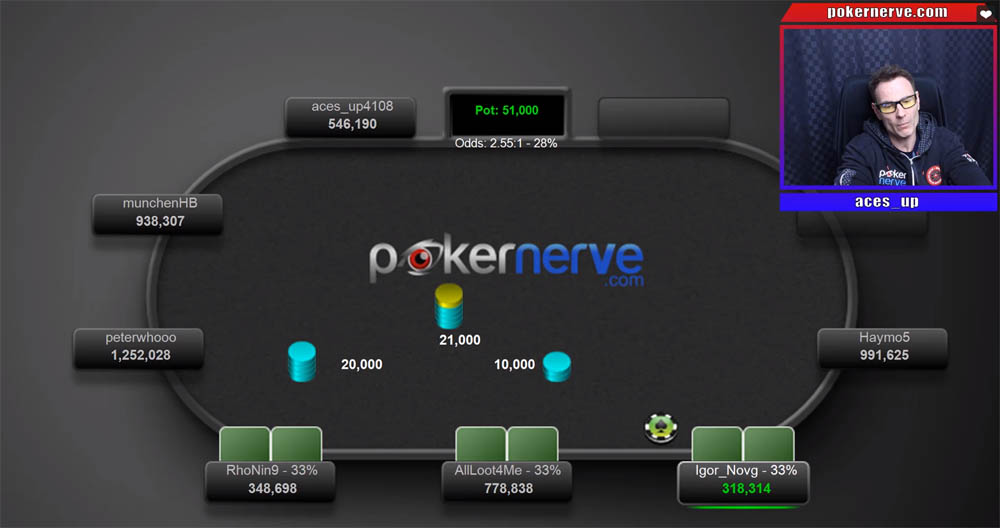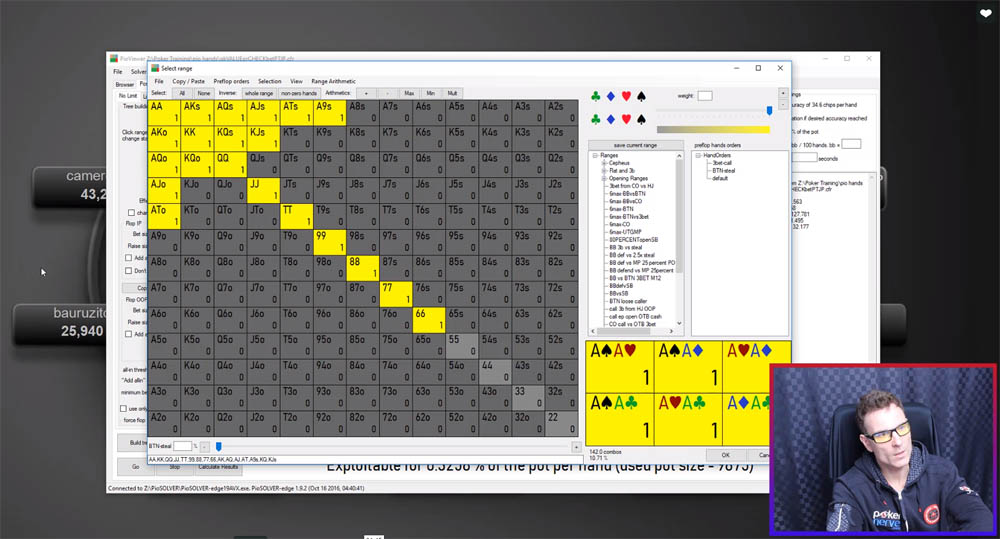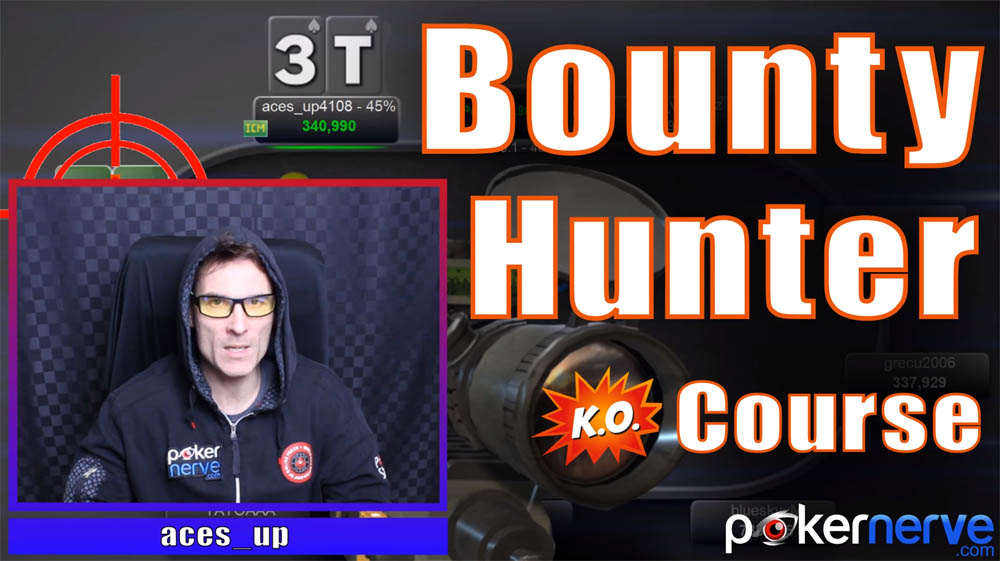There are many different poker formats out there. Every single one of them entails certain strategy adjustments and changes to playing style. In the world of multi-table tournaments (MTTs), one particular format has become quite popular as of late because it adds extra dynamics to the game-plan right from the first hand. The format is usually known as the “Progressive Knockout” or “Bounty Hunter” and that’s exactly what the latest PokerNerve Bounty Hunter course, is all about.
What makes these tournaments different from traditional knockout tournaments (KOs) is the fact the players’ bounties increase with every opponent they eliminate, so bounties aren’t static. You probably don’t need a poker expert to tell you that this will influence how you act in certain scenarios. Naturally, however, having an expert (or two) explain what these scenarios are and what adjustments you need to make is very helpful.
Over the course of several hours’ worth of video lessons (almost 20 hours altogether), Kelvin ‘Acesup’ Beattie and Ben Hayles break down every single aspect of Progressive Knockout tournaments (PKOs), using mathematical calculations and actual hand examples to create an excellent guide for this particular format.
Special for Cardplayer Lifestyle readers! Use promo code CPL to save 25%!
PokerNerve Bounty Hunter Course: Understanding What PKOs Are All About
The introductory video is a must-watch for anyone interested in improving their play in Progressive Knockouts. In it, “Acesup” explains the fundamental differences between PKOs and regular MTTs and how you can use a fairly simple formula to adjust your equities to account for the bounties.
The video offers a really good overview of how PKOs work and how the bounty pool changes as players bust. This is an essential introduction to everything that comes after in the course and it’s an excellent resource even if you’re completely new to bounty hunter tournaments. It really explains the format well and what you need to pay most attention to when playing.
Breakdown By Tournament Stages
Several segments of the PokerNerve Bounty Hunter course offer an excellent overview of game play at the three main stages of every tournament, namely:
- Early
- Middle
- Late
These videos are best watched in order. Every segment contains several lessons on particular subtopics, and videos are usually about 15 minutes long, so they’re easy to keep up with. Worth noting, both Beattie and Hayles do a good job of keeping things light and entertaining as much as possible, which definitely helps you maintain your focus while learning.

In the early stage videos, you’ll find a wealth of resources on how to approach bounty hunters during the period of play where the Independent Chip Model (ICM) is almost irrelevant. The segment is broken down by the stack depth, explaining necessary adjustments you’ll need to make vs. short, medium, and large stacks during early levels of a PKO.
The course utilizes Hold’em Resources Calculator (HRC) to come up with adjusted ranges for specific KO situations. The poker software does a pretty good job of this and you’ll be able to see in real time how adding or removing bounties changes calling and shoving ranges in particular scenarios.
Importantly, the course creators do account for the fact that HRC isn’t perfect as it doesn’t have the ability to account for new possibilities that open up once you have accumulated a really big stack in a PKO. Having a big stack in these tournaments is often of much bigger significance than having a big stack in a regular MTT where there isn’t the additional prize money to worry about.
After looking at early stage play, the PokerNerve Bounty Hunter Course moves on to middle stage play. In this phase, the ICM does start to have some influence but it’s still not a huge factor. Thus, you can still put a lot of focus on winning bounties.
In this section, “Acesup” explains how things start to change as players accumulate more bounties and how you can adjust your stealing and re-stealing ranges to account for these changing dynamics. He also explains the Bounty Factor (BF), a number that helps you make decisions on the spot and understand how equity requirements change.
Finally, the course talks about late stage and final table play. This is where ICM begins to really have an impact. To demonstrate the impact of ICM, “Acesup” compares bubble play in a regular $109 tournament on PokerStars and optimal play in a $109 bounty hunter tournament.

In this section, you’ll find a lot of good advice on how to make certain adjustments in the final stages of the tournament and take advantage of those players who fail to make such adjustments. With bounties in play, calling ranges become wider, which calls for tightening up and adjusting your shoving ranges.
A particularly interesting video in this section is the one on deal making. “Acesup” explains what things you should think about when making a deal and how different live and online poker rooms have different rules when it comes to bounties once a deal is struck. To put yourself in the best possible spot, you need to know these rules and account for them when making your decision.
Special for Cardplayer Lifestyle readers! Use promo code CPL to save 25%!
Isolating
After going through stage by stageplay, the PokerNerve Bounty Hunter course moves to a topic that’s important in MTTs in general but is especially significant in PKOs: isolating. With the added money from bounties, there is an additional incentive to play heads-up pots against shorter stacks and bust them. But, what’s the correct strategy here?
Focusing on four important factors, Beattie explains everything you need to know about potential isolation opportunities:
- Bounty Factor
- Equity
- Players yet to act (and do we cover them)
- ICM
In this section, you’ll also find out about some strategies specific to PKOs in light of isolation opportunities. For example, limping in becomes a much more viable approach in certain scenarios whereas this strategy is almost never used in regular MTTs. Added bounty dynamics make limping with the threat of isolation shoving a good option in certain scenarios.
Covering vs. Non-covering and Multi-way Pots
The final two sections of the PokerNerve Bounty Hunter course discuss how to adjust your play in situations depending on whether you cover or don’t cover your opponent and how to approach multi-way pots in PKO tournaments.
In terms of covering vs. not covering, you’ll pretty much be able to make many correct assumptions yourself by this point in the course. When you have a covering stack in pre-flop situations, you’ll be able to play looser, whether you’re the first in the pot or are calling or defending from the blinds.

In post-flop scenarios, when you have a player covered, you’ll want to build pots faster and not slow-play too much. Of course, you’ll find out what this means via concrete examples and what strategies to apply to achieve these results.
It’s worth mentioning that once you’re done with all the lessons, there is an in-depth review of a $530 online bounty builder tournament as played by “Acesup”. This provides a great summary of everything that’s been discussed as you can see many concepts as applied in actual play.
Summary: How Good is the PokerNerve Bounty Hunter Course?
PokerNerve’s Bounty Hunter course is definitely an interesting and rather unique product. They took a special niche within the MTT world and gave it an excellent, in-depth treatment. As some would say, the course “does what it says on the tin” and delivers on the promise to teach you about intricacies of playing progressive KOs.
Although you’ll find a fair bit of theory, formulas, and calculations (which are hardly ever too interesting to go through), Beattie and Hayles have really done a great job of keeping things light and easy to follow throughout. While the course is focused on a particular type of MTTs, you’ll also find a lot of general advice in there in terms of ranges and adjustments, so watching the videos is definitely worth your while even if PKOs aren’t your main focus.
In sum, if you want to develop a deeper understanding of bounty hunters and improve your ROI in these tournaments, this product will help you get there, and with a $374 price tag (a 25% discount from the regular price of $499) it’s a worthwhile investment to make in your poker game.









Comments